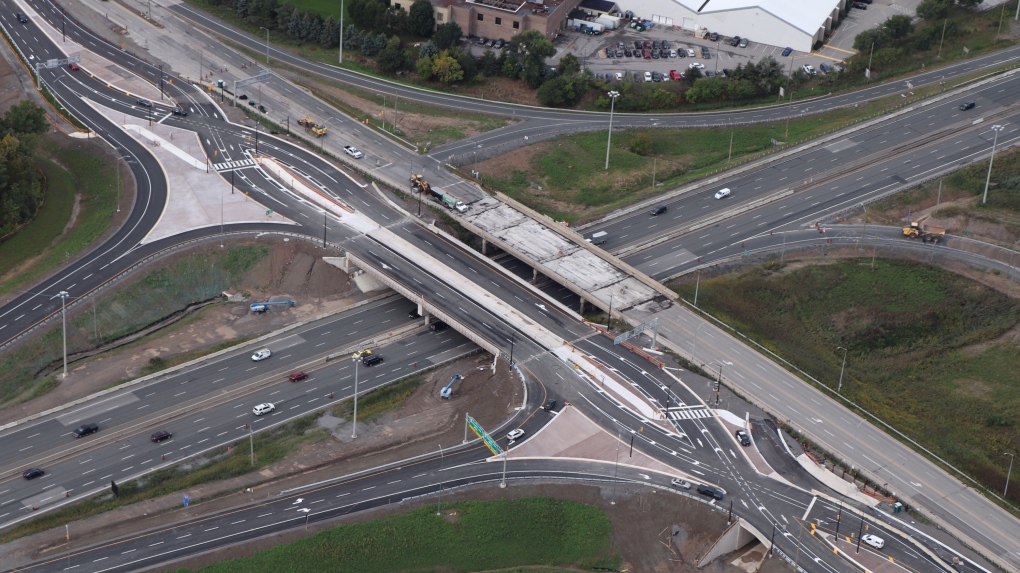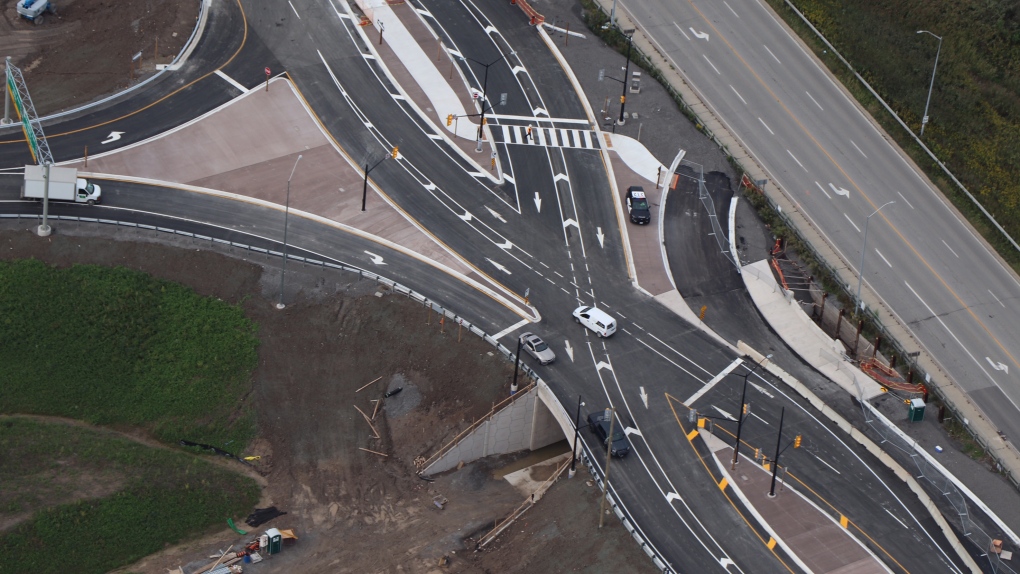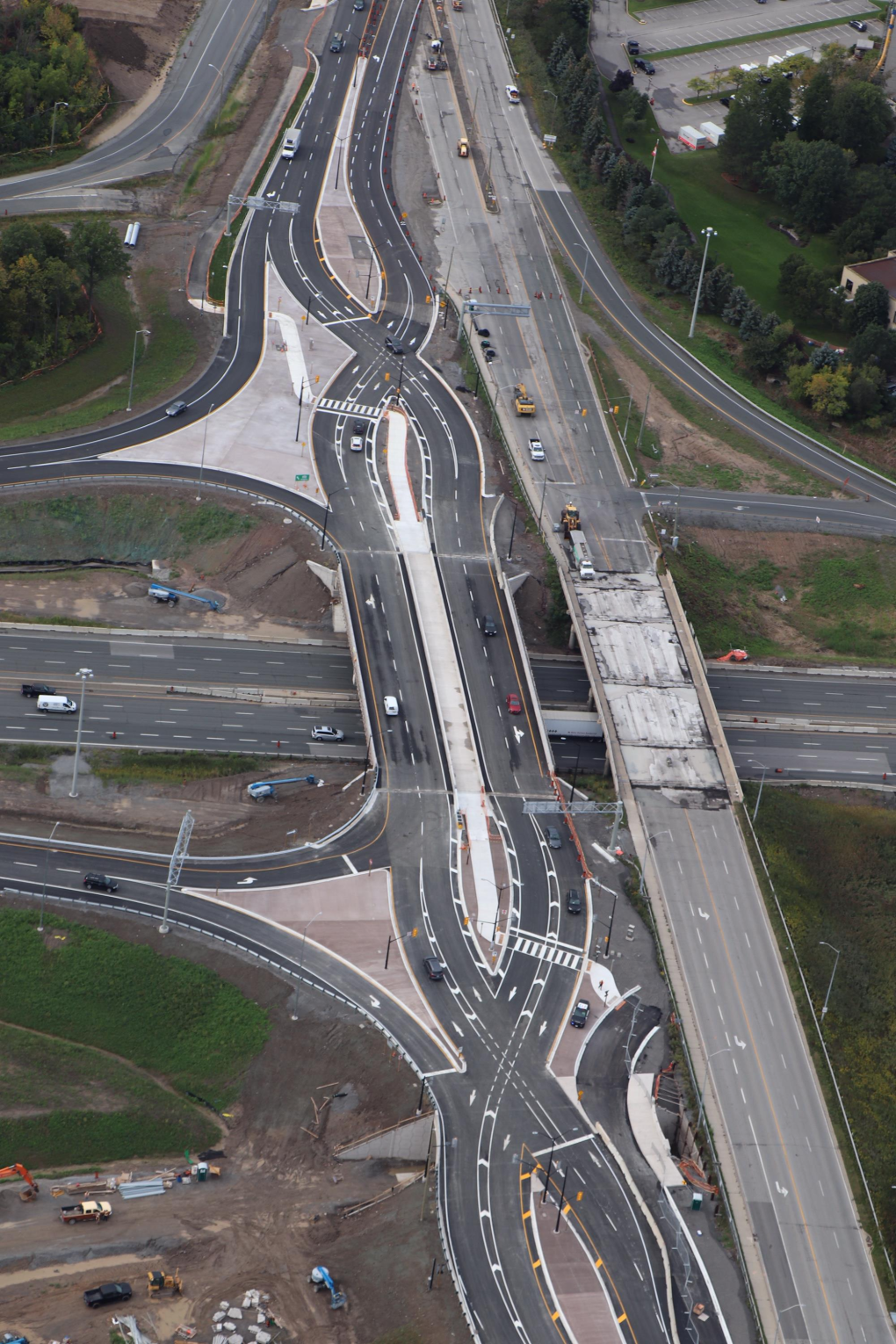Ontario's first diverging diamond interchange opens. Here's how it works
Ontario's first-ever diverging diamond interchange opens to drivers Monday morning, the Ministry of Transportation confirmed.
The new interchange, located at Glendale Avenue and the Queen Elizabeth Highway (QEW) in Niagara, will open to drivers on the morning of Sept. 26.
According to the Ministry of Transportation, the interchange has been installed to reduce gridlock and improve traffic flow for motorists getting on and off the QEW at Glendale Avenue.
It is supposed to accomplish this by reconfiguring traffic lanes to allow for direct access to all four directional highway ramps.
The diverging diamond interchange eliminates the need for motorists to make any left-hand turns when entering or exiting the highway by using a series of interconnected crossover lanes controlled by traffic lights and highway signage.
 The Queen Elizabeth Way and Glendale Avenue in Niagara, Ont. (CTV News Toronto)
The Queen Elizabeth Way and Glendale Avenue in Niagara, Ont. (CTV News Toronto)
"A diverging diamond interchange provides easier access and flow for traffic, cyclists, and pedestrians,” the ministry said in a statement to CTV News Toronto earlier this month.
"This interchange design will reduce the number of vehicle conflict points and allow unrestricted access to the QEW."
 (CTV News Toronto)
(CTV News Toronto)
While diverging diamond interchanges will be new to drivers in Ontario, they have been used in other places, like the U.S., for years. There are currently two diverging diamond interchanges in Canada, one in Calgary and the other in Regina.
The Ontario government held an in-person public education session to learn "how to navigate" the new interchange.
At that time, an animated drive-through video was released showing how Ontario's interchange works.
 (CTV News Toronto)
(CTV News Toronto)
CTVNews.ca Top Stories

B.C. tenants evicted for landlord's use after refusing large rent increase to take over neighbouring suite
Ashley Dickey and her mother rented part of the same Coquitlam duplex in three different decades under three different landlords.
Mountain guide dies after falling into a crevasse in Banff National Park
A man who fell into a crevasse while leading a backcountry ski group deep in the Canadian Rockies has died.
Expert warns of food consumption habits amid rising prices
A new survey by Dalhousie University's Agri-Food Analytics Lab asked Canadians about their food consumption habits amid rising prices.
MPP Sarah Jama asked to leave Ontario legislature for wearing keffiyeh
MPP Sarah Jama was asked to leave the Legislative Assembly of Ontario by House Speaker Ted Arnott on Thursday for wearing a keffiyeh, a garment which has been banned at Queen’s Park.
Charlie Woods, son of Tiger, shoots 81 in U.S. Open qualifier
Charlie Woods failed to advance in a U.S. Open local qualifying event Thursday, shooting a 9-over 81 at Legacy Golf & Tennis Club.
Ex-tabloid publisher testifies he scooped up possibly damaging tales to shield his old friend Trump
As Donald Trump was running for president in 2016, his old friend at the National Enquirer was scooping up potentially damaging stories about the candidate and paying out tens of thousands of dollars to keep them from the public eye.
Here's why provinces aren't following Saskatchewan's lead on the carbon tax home heating fight
After Prime Minister Justin Trudeau said the federal government would still send Canada Carbon Rebate cheques to Saskatchewan residents, despite Saskatchewan Premier Scott Moe's decision to stop collecting the carbon tax on natural gas or home heating, questions were raised about whether other provinces would follow suit. CTV News reached out across the country and here's what we found out.
Montreal actress calls Weinstein ruling 'discouraging' but not surprising
A Montreal actress, who has previously detailed incidents she had with disgraced Hollywood producer Harvey Weinstein, says a New York Court of Appeals decision overturning his 2020 rape conviction is 'discouraging' but not surprising.
Caleb Williams, Jayden Daniels and Drake Maye make it four NFL drafts with quarterbacks going 1-3
Caleb Williams is heading to the Windy City, aiming to become the franchise quarterback Chicago has sought for decades.

































